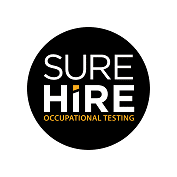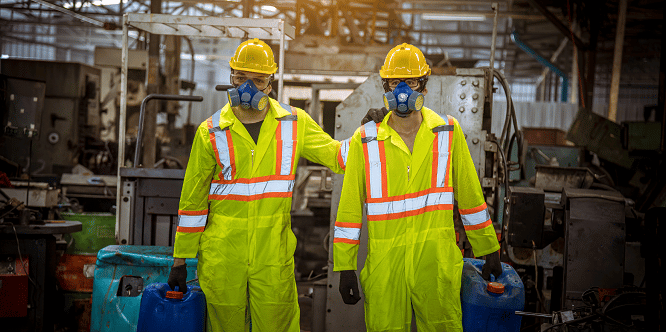TAKEAWAY: OSHA is one of several organizations integral to SureHire’s Respirator-Fit Testing service. We follow OSHA’s respirator-fit testing protocols to ensure the health and safety of the person wearing the respirator.
Jump Ahead
The Occupational Safety and Health Administration (OSHA) is one of several organizations integral to SureHire’s Respirator-Fit (Mask-Fit) Testing program. Alongside NIOSH, CSA, and OHS, they create the framework for how SureHire delivers this service. This article is the second in a series decoding these acronyms and explaining the essential functions of each organization. [Find out all about NIOSH in “What is NIOSH and Why is it Important for Respirator Fit Testing?”]
Respiratory Protective Equipment (RPE) helps prevent the inhalation of dangerous substances and the development of respiratory illnesses. It is essential for specific job roles in certain industries, including construction, mining, oil and gas, fire services, petrochemical, and pharmaceuticals.
Companies use Respirator-Fit Testing to ensure the RPE fits appropriately and keeps employees safe. Any employer using respirators and Respirator-Fit Testing should understand how various organizations influence this equipment and service. This article explores how OSHA helps lay the foundation for Respirator-Fit testing.

SureHire & OSHA Compliance
SureHire uses the OSHA-compliant Portacount Pro Respirator Fit Tester to measure and compare the concentration of particles in the ambient air and those that leak into the respirator. This quantitative method of respirator fit testing is considered the gold standard. SureHire only uses qualitative testing at partner locations where a Portacount Pro Respirator Fit Tester is unavailable.
What is OSHA?
OSHA is part of the United States Department of Labor. It is a regulatory agency created to ensure safe and healthy working conditions. OSHA fulfills its mission by setting and enforcing workplace health and safety standards and providing training, education, outreach, and assistance.
Congress first established OSHA under the Occupational Safety and Health Act (OSH). The OSH Act covers most private sector employers and their workers and some in the public sector, either through federal OSHA or an OSHA-approved state plan.
What is the Difference Between OSHA and NIOSH?
The Occupational Safety and Health Act of 1970 established OSHA and the National Institute for Occupational Safety and Health (NIOSH) to keep workers safe and healthy. NIOSH conducts health and safety research and provides recommendations for health and safety standards. OSHA then issues health and safety standards enforceable by U.S. law.
Employer responsibilities under OSH Act law
Employers must provide a workplace free from known dangers that could harm employees and follow all OSHA health and safety standards. Their responsibilities include the following:
- Adjust working conditions to reduce or eliminate hazards, for example, using effective ventilation systems to minimize inhalation of harmful substances
- Provide workers with sufficient training, education, and information about workplace hazards
- Prominently display the official OSHA rights and responsibilities poster and post OSHA injury and illness data where workers can see it.
- Perform or provide any tests required by OSHA standards
- Record workplace illnesses and injuries and notify OSHA about any workplace fatality within eight hours or injury within 24 hours.
Employee rights under OSH Act law
Employees have the right to safe and healthful working conditions under the OSH Act law. OSHA has four groups of standards (General Industry, Construction, Maritime, and Agriculture) designed to protect workers from hazards. Employee rights include the following:
- Employers must provide employees with Personal Protective Equipment (PPE) free of charge when it is needed
- Workers have the right to know about workplace hazards and how to protect themselves through appropriate information, training, and education initiatives from their employer.
- Employees have the right to access illness and injury records, exposure data, and personal medical records.
- Workers can file a complaint with OSHA about a potential workplace hazard or violation of OSHA standards. A complaint can trigger an on-site OSHA investigation.
- Workers have the right to further information and clarification if there is no inspection or citation from OSHA.
- Employees also receive whistle-blower protection to protect them from any resulting employer retaliation.
What role does OSHA play in Respirator-Fit Testing?
OSHA sets the standards for respirator safety in different industries. They also provide guidance and training related to respiratory protection. SureHire complies with OSHA’s respirator-fit testing protocols to ensure the safety and effectiveness of our Respirator-Fit Testing program.
General OSHA fit testing procedures for PPE, such as respirators, include the following:
- The tester is shown how to put on a respirator, where it should be positioned on the face, and how to adjust the tension straps.
- The test subject can eliminate respirators that do not offer an acceptable fit and can choose the model and size offering the best fit.
- The tester wears the most comfortable mask for at least five minutes to further assess its comfort. Other acceptable respirators are noted in case the primary choice is not ideal.
- A respirator-fit tester helps the test subject determine whether the mask is comfortable and fits well through various criteria. These include the mask position on different face parts, sufficient space for talking and eye protection, and the mask’s ability to remain in place.
- The respirator-fit tester determines when it is inappropriate to carry out tests or when the referral to a licensed health care professional is necessary.
- The test subject performs a range of exercises while testing the respirator as applicable to the testing method. These could include normal breathing, deep breathing, turning the head side to side or up and down, talking, making different facial expressions, or bending over.

SureHire & OSHA Compliance
SureHire uses the OSHA-compliant Portacount Pro Respirator Fit Tester to measure and compare the concentration of particles in the ambient air and those that leak into the respirator. This quantitative method of respirator fit testing is considered the gold standard. SureHire only uses qualitative testing at partner locations where a Portacount Pro Respirator Fit Tester is unavailable.
Respirator-Fit Testing and OSHA | In Conclusion
OSHA is one of several organizations integral to SureHire’s Respirator-Fit Testing service. They issue health and safety standards for respirators, enforceable by U.S. law. SureHire follows OSHA’s respirator-fit testing protocols to ensure the health and safety of the person wearing the respirator.
Employees in industries with a high risk of lung health issues should invest in Respirator-Fit Testing to protect employees fully. These include mining, manufacturing, construction, and agriculture. Contact SureHire for more information about lung health testing services such as Respirator-Fit Testing, Spirometry Testing, Lead Exposure and Health Monitoring, and Lung Health Monitoring programs.
You May Also Be Interested In…
- Do You Have Reasonable Suspicion?
 Employers cannot initiate reasonable suspicion testing without first going through the 5-step process. Reasonable suspicion training provides critical information about how to initiate reasonable suspicion testing, including the 5-step process and other tools that employers can use to help manage the misuse of alcohol and drugs in the workplace.
Employers cannot initiate reasonable suspicion testing without first going through the 5-step process. Reasonable suspicion training provides critical information about how to initiate reasonable suspicion testing, including the 5-step process and other tools that employers can use to help manage the misuse of alcohol and drugs in the workplace. - An Employer’s Guide: What You and Your Employees Need to Know About DOT Drug & Alcohol Testing
 When implementing or maintaining DOT Drug & Alcohol testing, there are key areas that employers should consider.
When implementing or maintaining DOT Drug & Alcohol testing, there are key areas that employers should consider. - SureHire Occupational Testing Acquires COHR Health: A Positive Step Towards Safe, Healthy, Productive Workforces and Communities
 We are thrilled to announce that today, May 6, 2024, SureHire Occupational Testing has officially acquired COHR Health, a well-known leader in occupational health services. Read on…
We are thrilled to announce that today, May 6, 2024, SureHire Occupational Testing has officially acquired COHR Health, a well-known leader in occupational health services. Read on… - Occupational Testing Use Case – Mining
 In this case study, we will explore how mining companies can use various types of occupational tests to reduce Total Recordable Incident Rates (TRIR) long term.
In this case study, we will explore how mining companies can use various types of occupational tests to reduce Total Recordable Incident Rates (TRIR) long term. - 9 Strategies to Keep Workers Cool on Drilling Sites During Hot Summer Months
 This article delves into strategies to keep workers cool and safe on drilling sites during the hot summer months.
This article delves into strategies to keep workers cool and safe on drilling sites during the hot summer months. - Hearing Conservation Basics: How to Manage Occupational Noise
 Learn how to proactively mitigate occupational noise risks and help prevent NIHL among workers.
Learn how to proactively mitigate occupational noise risks and help prevent NIHL among workers.

